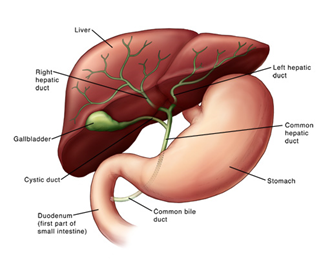Gallstone Disease Treatment
If you experience symptomatic gallstones, there are a number of different treatment options available. Your exact course of treatment will depend on your symptoms and the characteristics of the gallstones you have. The goal of treatment is to relieve symptoms and prevent complications from developing. Treatment for gallstones includes:
- Medication
- Surgery
- Percutaneous therapy
- Endoscopic gallbladder stenting
- Treating complications of gallstones
Gallstone Disease Treatment: Medication
There are several medications available for symptomatic gallstones, which are designed to:
- Interfere with the development of gallstones in the gallbladder
- Dissolve the stones
These medications are only useful in patients who have small, non-calcified cholesterol stones and whose gallbladder is functioning normally. Therapy takes at least six to 12 months. There is a chance that the gallstones will recur within five years.
Gallstone Disease Treatment: Surgery
Cholecystectomy is surgery to remove your gallbladder. It is the only treatment option to cure symptomatic gallstones. Laparoscopic cholecystectomy is the most common procedure instead of a traditional, open procedure. During a laparoscopic cholecystectomy, your surgeon:
- Makes a few small incisions in your abdomen rather than one large one
- Inserts a miniature video camera and laparoscopic instruments into the incision
- Removes the gallbladder and closes the incisions with stitches
Advantages of a laparoscopic procedure include:
- Less pain
- Shorter hospital stay
- Faster return to normal activities
Sometimes, a surgeon begins the procedure using a laparoscopic approach but then switches to an open approach because of scarring, infection or other complications. No matter which approach your doctor uses, he or she has your best possible outcome in mind.
Gallstone Disease Treatment: Percutaneous Therapy
In certain high-risk patients, surgery may be too dangerous. A percutaneous (through the skin) treatment approach may be used. During this procedure, your doctor opens the gallbladder, dilates the tract and removes any gallstones using a device called a cholecystoscope.
Another percutaneous method is called contact dissolution therapy. During this procedure, a catheter is inserted into your gallbladder, and a solvent is injected directly to the gallbladder. The solvent dissolves the cholesterol stones.
Gallbladder Disease Treatment: Endoscopic Gallbladder Stenting
Endoscopic gallbladder stenting is another nonsurgical approach to treat gallstones. It is useful in treating high-risk patients who cannot undergo surgery, usually due to an illness. During this procedure, your doctor performs an ERCP and inserts a stent from the gallbladder to the duodenum. The stent relieves biliary symptoms and complications.
Treating Complications of Gallbladder Disease
Certain complications may arise in patients with gallbladder disease. Your doctor will discuss with you the risks of complications.
- Acute cholecystitis: This is the most common complication, and it occurs when the gallstone becomes impacted in the cystic duct. The bile is then trapped in the gallbladder, causing damage and inflammation. Usually, a cholecystectomy (removal of the gallbladder) is the best treatment.
- Choledocholithiasis: This occurs when gallstones become displaced to the common bile duct rather than to the gallbladder. Choledocholithiasis can cause life-threatening conditions. An ERCP can be performed to diagnose and treat these gallstones.
Less common complications include:
- Cholecystoenteric fistulas, which form when a large stone erodes through the gallbladder into the bowel. Treatment involves cholecystectomy and bowel resection.
- Mirizzi’s syndrome is the result of a gallstone blocking the cystic duct, compressing the common bile duct and causing inflammation. ERCP is used to diagnose and treat it.
- Porcelain gallbladder occurs when the gallbladder wall calcifies (hardens), usually because of gallstones. This can lead to gallbladder cancer, so removal of the gallbladder is recommended.


.png?h=159&iar=0&w=200&hash=BB0546578AA2C629B7716D48DFCFF0E1)

.png?h=159&iar=0&mh=260&mw=380&w=200&hash=BDC1A4D1D0E741F299FD1F3151D7213A)

